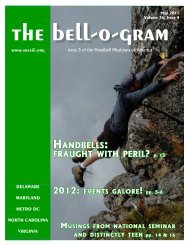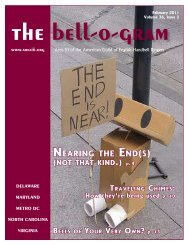Congratulations - Area III
Congratulations - Area III
Congratulations - Area III
- No tags were found...
You also want an ePaper? Increase the reach of your titles
YUMPU automatically turns print PDFs into web optimized ePapers that Google loves.
Bells In Worshipby Jerry Hill, Metro DC Chairjdeanhill@aol.comMuch discussion has been had recentlyon the use of bells in worship. Is therea place for them with the current trendsin worship styles? Is bell music stillmeaningful to the listener, or has the art form seen its day?A few years ago, I became the director of a handbell groupwhich had been given the name Adoration Ringers. Ienvisioned my yearly goals, planned my budget, and penneda schedule each year with a concert at the end of the bellseason. I meet weekly with my group of 12 to 15 membersand organized rehearsals to meet our goals for the monthlyperformance in our worship services. I charted specialconcerts during Advent and Lent season. I never stopped toask the question, “What is the meaning of our name?”Afterdcpausing to reflect on the meaning of “adoration,” Isoon realized that we were representing worship. Did thefounding members or music director have some particularmessage in the group? Where did the name come from? Isoon came to the realization that someone just liked thename and thought it was a great name to call the group.I began to search deeper as to what were we doing. Werewe just gathering to play together? Did we have a messageto share? Did we have a love for the unique art form? As Ibegan to reflect on the members of the group, names andfaces of current and former members came to my attention.I begin to analyze why we came together. It was to worship.Commitment. Worship is usually understood as areverence or regard for something, maybe a deity or God.Many bell members come to their rehearsals week after weekbecause they are committed to the art form.Compassion. They love what they do. They sense a needto belong. Some members feel a need to share their talentswith their Creator. They desire to understand the emotionswithin the score and provide meaning to the listeners.Concentration. True worship offers individualsopportunities for solitude and reflection. The listenersescape to new zones of emotional meaning and refreshingof the spirit. They reach peak experiences with selfactualization.Context. Carefully considering a composition, with theringers’ abilities and the appreciation of intended audiencesin mind, helps create genuine worship through the art form.It is not something that just happens. It must be plannedwith flexibility with the result.Curriculum. We must prepare the spirit for worship. Thisis a developmental process. Our music selections mustreflect the audience that will hear us.Are bells for worship? Definitely! We must be good stewardsin our endeavors to create meaningful music.Springtime inNorth Carolinaby Marilyn Reese, North Carolina Chairmlrncbells@nc.rr.comBudding trees, blooming flowers,rainbow colors, heavenly scents, crashingthunder, brilliant white lightning, softrain, and warm air all announce the beauty of spring.These visual scenes remind me of the many facets of musicneeded to elicit the best in musical interpretation. Throughcrescendos, decrescendos, tempo, rhythm, ritards, andtechniques, we add “color” to music....including handbellmusic.From years of attending handbell events, I have heardnational-level clinicians strive to educate us in the best ofhandbells. Christine Anderson (solo ringer) advocateslearning everything (not just notes, but phrasing anddynamics) starting in the very first rehearsal. Bill Paynpreaches the art of expression in handbell ringing. HartMorris values accurate rhythms. Tim Waugh stresses preciseringing techniques. Michael Glasgow strives for the messagebehind the music. Charm Peterman promotes teachingyour brain to read the music perfectly before even ringing abell. Fred Gramann hopes you will develop a rapport withyour director (meaning heads up and watch the director).I hope you have experienced the joy and rewards ofworking with clinicians at Guild events. They bring artisticskills to mastering handbell ringing. Just ringing notes isnot acceptable! (Or even all that enjoyable, once you’veexperienced what else you can accomplish!)What happens if we just ring the right notes at the righttime? We play as loud cymbals! The beauty of our art formis in its expression. Have you heard the Raleigh Ringers?The appropriate expression brought to each piece of musiccreates life in the offering. Just ringing the right note at theright time does not achieve quality handbell ringing.How do we bring the many elements of ringing together?Start with the Guild’s Handbell and Handchime Notationbooklet (AGR101), which defines the correct ringingtechniques noted in our handbell music, techniques thathave evolved and changed to an accepted standard. Studythis text and ensure you know what all of those symbolsmean, and how to execute them properly.Next, open your music to the first measure and to the lastpage. These are the two critical parts most of our audienceswill remember. To begin, rehearse slowly and methodically,including all techniques and dynamic levels. Memorizethe beginning and ending challenging measures so youcan watch the director for cues. As the music is mastered,increase the tempo until the stated tempo is achieved.Voilà! Success! Satisfaction! Joy! Fun!I wish you a spring of beautiful, expressive ringing; a springin your ring; and results that spring you into successfulringing!12






